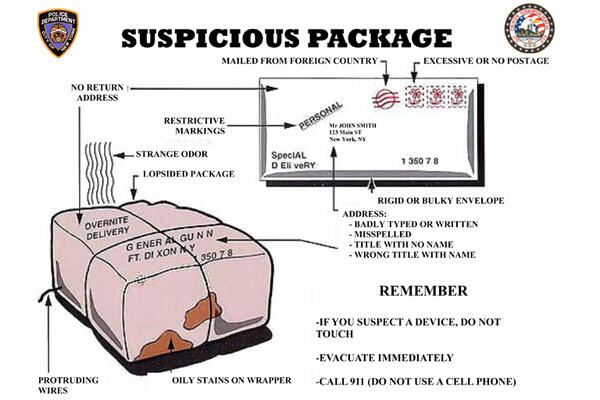


Read our book on crisis management: Vital Signs: Anticipating, Preventing and Surviving Crisis in a Nonprofit. You may also want to review resources from the Federal Bureau of Investigation and the Centers for Disease Control for additional information and resources. Wash your hands with soap and warm water.Call local fire department/Hazmat unit.If a letter/parcel is open and/or a threat is identified: For a Bomb: If you receive a suspicious letter or package: Don’t Open Any Parcel Until Verified as Safe They address general suspicions and specifics for bomb threats, radiological threats, biological or chemical threats. What is the chain of command for reporting suspicious deliveries?įollowing are some Suspicious Mail Guidelines provided by the U.S.What should other employees do if they receive a parcel they aren’t expecting or which can’t be explained?.Where can personnel refer to verify a return address is legitimate?.How are personnel to verify that a delivery is expected?.What guidelines are provided to mailroom personnel for identifying and reporting suspicious packages or letters?.How is their training updated? How often?.

What type of training is supplied for mailroom personnel?.Is there a separate room that can be designated as the mailroom?.Can you identify a single person and an alternate responsible for receiving, and screening letters and parcels prior to distributing these items to the staff?.Is it possible to streamline the process?.Some of the questions you’ll want to ask are: The second step is to review your entity’s or organization’s policies and procedures for handling mail and package deliveries and distribution. Has strange odors or stains, or protruding wires.Is marked with restrictive endorsements,such as “Personal” or “Confidential.”.Is of unusual weight, given its size, or is lopsided or oddly shaped.Has no return address or one that can’t be verified as legitimate.Is addressed to someone no longer with your organization or is otherwise outdated.Has excessive postage, is handwritten or contains a poorly typed address, incorrect title or just a title with no name, or misspells common words.Is unexpected or from someone unfamiliar to you.Has any powdery substance on the outside.General Suspicious Mail Indicatorsīe Suspicious of any Letter or Package that: Hold a meeting to explain the added precautions, if they are new to your entity or organization, or to refresh the memory of staff where these procedures are in place. Ideally, this will be the mailroom supervisor or staff members serving as the mail point person. This should be distributed to everyone who receives or opens letters and packages at your entity or organization.

The first step is to post a list of typical characteristics that should alert employees to a suspicious package. However, these weapons or the threat of their use are disruptive forces and you want to take a proactive preventive stance. The USPS says, “The chances are considerably greater of receiving a telephoned bomb threat or finding a suspicious and potentially harmful device placed at your office or on your property” than receiving a mail bomb. Small government entities or nonprofit organizations are especially vulnerable because many don’t have a centralized mailroom or designate a single person to receive and distribute the mail.Īlthough relatively low cost and simple in design, chemical and biological weapons haven’t been prevalent in the United States up to now according to the U.S. Mailroom security, an area often overlooked as policies and procedures are created or updated to reduce risks and losses, has risen in importance following the biological scares in late 2001.


 0 kommentar(er)
0 kommentar(er)
